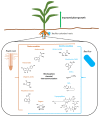Bacillus for Plant Growth Promotion and Stress Resilience: What Have We Learned?
- PMID: 36235347
- PMCID: PMC9571655
- DOI: 10.3390/plants11192482
Bacillus for Plant Growth Promotion and Stress Resilience: What Have We Learned?
Abstract
The rhizosphere is a thin film of soil that surrounds plant roots and the primary location of nutrient uptake, and is where important physiological, chemical, and biological activities are occurring. Many microbes invade the rhizosphere and have the capacity to promote plant growth and health. Bacillus spp. is the most prominent plant growth promoting rhizobacteria due to its ability to form long-lived, stress-tolerant spores. Bacillus-plant interactions are driven by chemical languages constructed by a wide spectrum of metabolites and lead to enhanced plant growth and defenses. Thus, this review is a synthesis and a critical assessment of the current literature on the application of Bacillus spp. in agriculture, highlighting gaps that remain to be explored to improve and expand on the Bacillus-based biostimulants. Furthermore, we suggest that omics sciences, with a focus on metabolomics, offer unique opportunities to illuminate the chemical intercommunications between Bacillus and plants, to elucidate biochemical and molecular details on modes of action of Bacillus-based formulations, to generate more actionable insights on cellular and molecular events that explain the Bacillus-induced growth promotion and stress resilience in plants.
Keywords: Bacillus; biostimulant; metabolomics; plant growth; stress resilience.
Conflict of interest statement
The authors declare no conflict of interest.
Figures




Similar articles
-
Biostimulants for Plant Growth and Mitigation of Abiotic Stresses: A Metabolomics Perspective.Metabolites. 2020 Dec 10;10(12):505. doi: 10.3390/metabo10120505. Metabolites. 2020. PMID: 33321781 Free PMC article. Review.
-
Temperature-induced modulation of stress-tolerant PGP genes bioprospected from Bacillus sp. IHBT-705 associated with saffron (Crocus sativus) rhizosphere: A natural -treasure trove of microbial biostimulants.Front Plant Sci. 2023 Feb 27;14:1141538. doi: 10.3389/fpls.2023.1141538. eCollection 2023. Front Plant Sci. 2023. PMID: 36923125 Free PMC article.
-
Untargeted metabolite profiling to elucidate rhizosphere and leaf metabolome changes of wheat cultivars (Triticum aestivum L.) treated with the plant growth-promoting rhizobacteria Paenibacillus alvei (T22) and Bacillus subtilis.Front Microbiol. 2022 Aug 25;13:971836. doi: 10.3389/fmicb.2022.971836. eCollection 2022. Front Microbiol. 2022. PMID: 36090115 Free PMC article.
-
Plant Growth-Promoting Rhizobacteria: Context, Mechanisms of Action, and Roadmap to Commercialization of Biostimulants for Sustainable Agriculture.Front Plant Sci. 2018 Oct 23;9:1473. doi: 10.3389/fpls.2018.01473. eCollection 2018. Front Plant Sci. 2018. PMID: 30405652 Free PMC article. Review.
-
Bacillus subtilis: A plant-growth promoting rhizobacterium that also impacts biotic stress.Saudi J Biol Sci. 2019 Sep;26(6):1291-1297. doi: 10.1016/j.sjbs.2019.05.004. Epub 2019 May 20. Saudi J Biol Sci. 2019. PMID: 31516360 Free PMC article. Review.
Cited by
-
Stigmas of holoparasitic Phelipanche arenaria (Orobanchaceae) - a suitable ephemeric flower habitat for development unique microbiome.BMC Plant Biol. 2023 Oct 11;23(1):486. doi: 10.1186/s12870-023-04488-1. BMC Plant Biol. 2023. PMID: 37821804 Free PMC article.
-
Assessment of the Biocontrol Potential of Bacillus velezensis WL-23 against Kiwifruit Canker Caused by Pseudomonas syringae pv. actinidiae.Int J Mol Sci. 2023 Jul 16;24(14):11541. doi: 10.3390/ijms241411541. Int J Mol Sci. 2023. PMID: 37511299 Free PMC article.
-
Bioremediation of Heavy Metals by the Genus Bacillus.Int J Environ Res Public Health. 2023 Mar 11;20(6):4964. doi: 10.3390/ijerph20064964. Int J Environ Res Public Health. 2023. PMID: 36981874 Free PMC article. Review.
-
Bacilli Rhizobacteria as Biostimulants of Growth and Production of Sesame Cultivars under Water Deficit.Plants (Basel). 2023 Mar 16;12(6):1337. doi: 10.3390/plants12061337. Plants (Basel). 2023. PMID: 36987028 Free PMC article.
-
Bacillus Species: Excellent Biocontrol Agents against Tomato Diseases.Microorganisms. 2024 Feb 24;12(3):457. doi: 10.3390/microorganisms12030457. Microorganisms. 2024. PMID: 38543508 Free PMC article. Review.
References
-
- Kleinwechter U., Gastelo M., Ritchie J., Nelson G., Asseng S. Simulating cultivar variations in potato yields for contrasting environments. Agric. Syst. 2016;145:51–63. doi: 10.1016/j.agsy.2016.02.011. - DOI
-
- Backer R., Rokem J.S., Ilangumaran G., Lamont J., Praslickova D., Ricci E., Subramanian S., Smith D.L. Plant Growth-Promoting Rhizobacteria: Context, Mechanisms of Action, and Roadmap to Commercialization of Biostimulants for Sustainable Agriculture. Front. Plant Sci. 2018;9:1473. doi: 10.3389/fpls.2018.01473. - DOI - PMC - PubMed
Publication types
LinkOut - more resources
Full Text Sources
Miscellaneous

